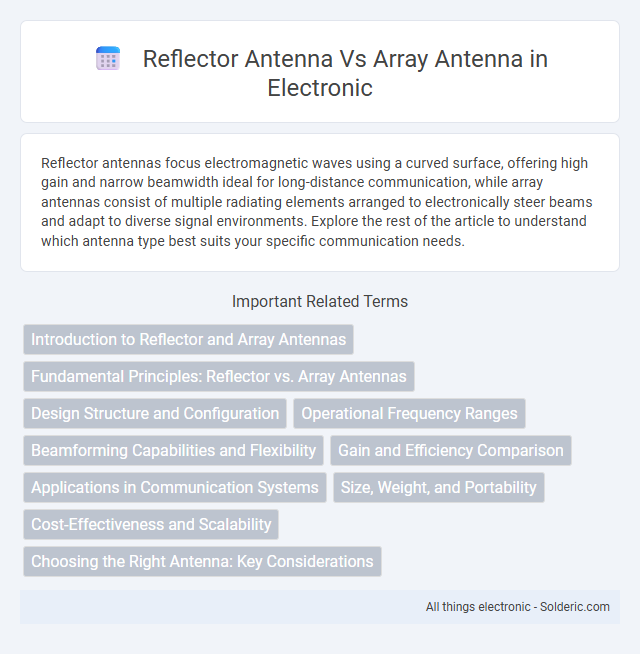Reflector antennas focus electromagnetic waves using a curved surface, offering high gain and narrow beamwidth ideal for long-distance communication, while array antennas consist of multiple radiating elements arranged to electronically steer beams and adapt to diverse signal environments. Explore the rest of the article to understand which antenna type best suits your specific communication needs.
Comparison Table
| Feature | Reflector Antenna | Array Antenna |
|---|---|---|
| Structure | Single reflector surface (parabolic, spherical) | Multiple radiating elements arranged in a pattern |
| Beamforming | Fixed; shaped by reflector geometry | Electronic beam steering possible |
| Gain | High gain from focused reflection | Variable gain, depending on number of elements |
| Frequency Range | Primarily microwave and higher frequencies | Wide frequency range, depends on element design |
| Size & Weight | Generally larger, heavier | Compact, scalable based on element count |
| Complexity | Simple structure, passive | Complex control, active elements |
| Applications | Satellite dishes, radar, radio telescopes | Phased arrays for radar, 5G, MIMO systems |
| Cost | Lower initial cost | Higher cost due to active electronics |
Introduction to Reflector and Array Antennas
Reflector antennas use a curved surface to focus incoming signals onto a single focal point, achieving high gain and directivity ideal for satellite communication and radar systems. Array antennas consist of multiple radiating elements arranged in a specific pattern, enabling beamforming and electronic steering for improved signal control and flexibility. Your choice between these antennas depends on the application requirements such as gain, beamwidth, and operational frequency.
Fundamental Principles: Reflector vs. Array Antennas
Reflector antennas operate by using a curved surface, typically parabolic, to focus electromagnetic waves onto a single focal point, enhancing signal strength and directivity. Array antennas consist of multiple individual radiating elements arranged in a specific geometric pattern, where the combined signal phases control the beam direction and shape through constructive and destructive interference. Your choice between these depends on the need for high gain and simplicity with reflector antennas or beam steering and flexibility with array antennas.
Design Structure and Configuration
Reflector antennas utilize a parabolic or curved surface to focus electromagnetic waves onto a single focal point, optimizing signal strength and directionality with a simple yet robust design. Array antennas consist of multiple radiating elements arranged in specific geometric patterns, enabling beamforming and direction control through constructive and destructive interference. Your choice between these configurations depends on requirements for spatial resolution, beam steering capability, and physical size constraints.
Operational Frequency Ranges
Reflector antennas typically operate effectively within microwave to millimeter-wave frequency ranges, generally from 1 GHz up to 100 GHz, making them ideal for satellite communications and radar systems. Array antennas offer a broader operational frequency range, spanning from VHF (30 MHz) through millimeter waves (up to 100 GHz or more), providing flexibility for applications in telecommunications, radar, and wireless networks. The choice between reflector and array antennas depends on frequency-specific requirements such as beam steering, gain, and bandwidth.
Beamforming Capabilities and Flexibility
Reflector antennas provide highly focused beamforming with excellent gain but offer limited flexibility in dynamically steering the beam compared to array antennas. Array antennas enable advanced beamforming techniques with electronic steering, allowing rapid adjustment of beam direction and shape without physical movement. Your choice depends on whether precise, high-gain focus or adaptable, agile beam control is prioritized.
Gain and Efficiency Comparison
Reflector antennas typically offer higher gain due to their large aperture size, efficiently focusing energy into a narrow beam, which enhances signal strength in a specific direction. Array antennas provide flexible beamforming capabilities but may have slightly lower gain as individual elements share the total radiated power. Your choice depends on whether maximum gain or adaptive beam steering is more critical for the application.
Applications in Communication Systems
Reflector antennas excel in satellite communication and radar systems due to their high gain and narrow beamwidth, enabling long-distance signal transmission and reception. Array antennas are widely used in advanced wireless networks and radar systems for their beamforming capabilities and electronic steering, facilitating dynamic multi-beam coverage and interference mitigation. Your choice depends on application requirements like coverage area, frequency, and system complexity.
Size, Weight, and Portability
Reflector antennas typically have larger sizes and bulkier structures due to their parabolic dishes, leading to heavier weight and limited portability compared to array antennas. Array antennas consist of multiple smaller elements arranged in a grid, making them more compact, lightweight, and easier to transport or reconfigure in various environments. The adaptability and reduced size of array antennas make them ideal for mobile and space-constrained applications, while reflector antennas excel in fixed installations requiring high-gain performance.
Cost-Effectiveness and Scalability
Reflector antennas generally offer higher cost-effectiveness for single, high-gain applications due to their simpler construction and lower material requirements. Array antennas provide superior scalability, allowing you to expand or modify the system by adding more elements to improve gain, beam steering, or multiple beamforming capabilities. Your choice depends on balancing initial investment with future adaptability in antenna system performance.
Choosing the Right Antenna: Key Considerations
Reflector antennas offer high gain and focused beamwidth, ideal for long-distance communication and satellite dishes, while array antennas provide flexibility in beam steering and frequency adaptability, suitable for radar and mobile networks. Your choice depends on factors like coverage area, frequency band, installation environment, and cost constraints. Evaluating these parameters ensures optimal performance tailored to your specific application requirements.
reflector antenna vs array antenna Infographic

 solderic.com
solderic.com